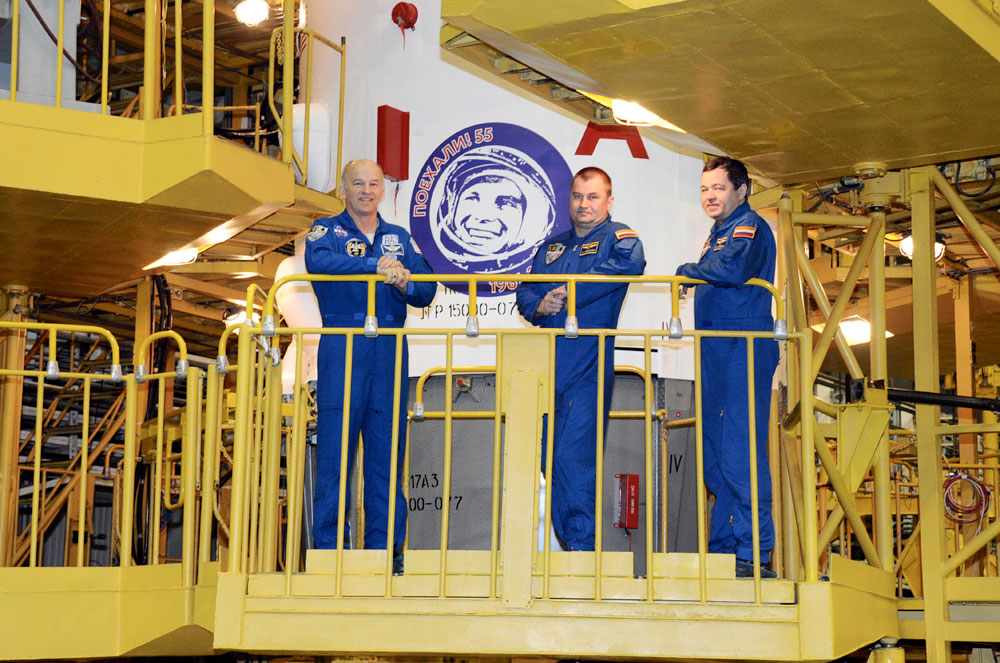'Year of Yuri Gagarin' Logo Added to Rocket Launching Next Space Station Crew

Yuri Gagarin, the first person to fly into space, will be joining the three-member crew launching to the International Space Station this week, in the form of his smiling face decorating the side of their rocket.
The cosmonaut's image was added to the booster to mark the Russian space agency's year-long commemoration of Gagarin's historic April 12, 1961 flight. The blue and white portrait was applied to the fairing – or launch shroud – that will shield the Soyuz TMA-20M spacecraft as it ascends to space on a Soyuz rocket from the Baikonur Cosmodrome in Kazakhstan on Friday (March 18).
The launch, scheduled for 5:26 p.m. EDT (2126 GMT; 3:26 a.m. Kazakh time), will bring cosmonauts Alexey Ovchinin and Oleg Skripochka and NASA astronaut Jeff Williams to the space station for a planned docking later that night at 11:12 p.m. EDT (0312 GMT March 19).
Ovchinin, the commander and only rookie flier aboard the Soyuz, will be the 544th person to follow Gagarin into orbit. Ovchinin, Skripochka and Williams will fly from "Gagarin's Start," the same launch pad that the first cosmonaut used to begin his Vostok 1 mission 55 years ago. [Yuri Gagarin: Photos of the First Man in Space]
The Soyuz rocket's decoration reproduces the logo for the "Year of Yuri Gagarin," a jubilee celebration announced by Roscosmos in late February.
"To commemorate this milestone in human [space] history, Roscosmos proclaims 2016 to be the Year of Yuri Gagarin and plans a number of interesting events," Russian space officials stated in a release. "Let's remember together how it was and dream about the future — because it is just the beginning!"
The cosmonauts already onboard the space station helped to launch the celebration, holding a sign reading "Gagarin. Lift-Off!" in Cyrillic.
Get the Space.com Newsletter
Breaking space news, the latest updates on rocket launches, skywatching events and more!
"Dear friends, we declare that the jubilee for the 55th year of manned flight into space is the 'Year of Gagarin,'" said Mikhail Kornienko, who with astronaut Scott Kelly returned to Earth on March 1, ending a record 340-day mission.
"Our new motto is 'Lift Your Head Up!' because every time we [do], we can see the stars," added Yuri Malenchenko, who will welcome Ovchinin, Skripochka and Williams onto the space station.
![The "Year of Yuri Gagarin" logo reads "POYEKHALI! [GO!] 55."](https://cdn.mos.cms.futurecdn.net/Yxk54EFv9FURzCHan9tYZf.jpg)
According to Roscosmos, additional events and exhibitions are planned to mark the "Year of Yuri Gagarin."
"We invite all those who are interested in space, dream of distant planets and for who Russia's space activities are a part of life to join us," stated the space agency.
Yuri Gagarin, who would have turned 82 on March 9, died in a training jet crash on March 27, 1968. Vostok 1 was his only flight into space.
The fairing displaying Gagarin's portrait will be jettisoned from the Soyuz rocket about two minutes and 40 seconds into Friday's launch.
See the placement of the 'Year of Yuri Gagarin' logo on the Soyuz rocket at collectSPACE.
Follow collectSPACE.com on Facebook and on Twitter at @collectSPACE. Copyright 2016 collectSPACE.com. All rights reserved.
Join our Space Forums to keep talking space on the latest missions, night sky and more! And if you have a news tip, correction or comment, let us know at: community@space.com.

Robert Pearlman is a space historian, journalist and the founder and editor of collectSPACE.com, a daily news publication and community devoted to space history with a particular focus on how and where space exploration intersects with pop culture. Pearlman is also a contributing writer for Space.com and co-author of "Space Stations: The Art, Science, and Reality of Working in Space” published by Smithsonian Books in 2018.In 2009, he was inducted into the U.S. Space Camp Hall of Fame in Huntsville, Alabama. In 2021, he was honored by the American Astronautical Society with the Ordway Award for Sustained Excellence in Spaceflight History. In 2023, the National Space Club Florida Committee recognized Pearlman with the Kolcum News and Communications Award for excellence in telling the space story along the Space Coast and throughout the world.










